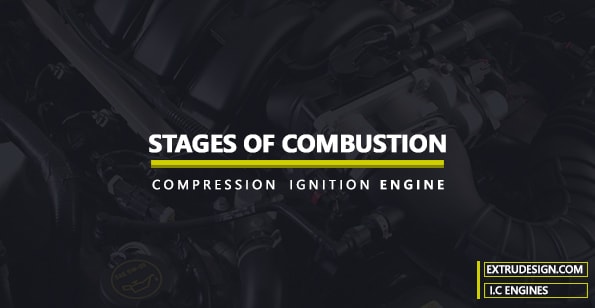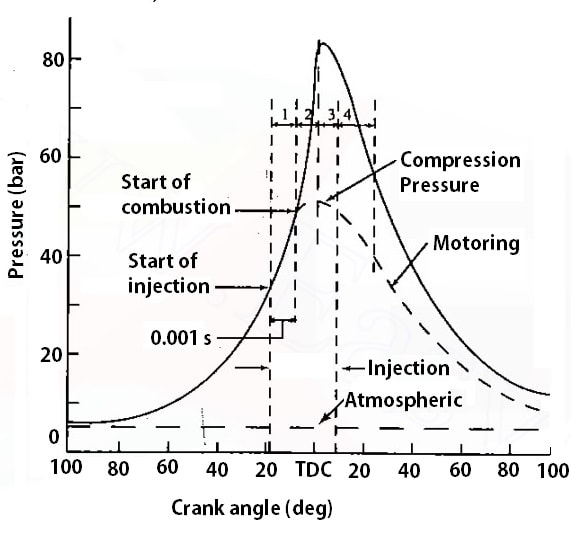Combustion is a chemical reaction which generates heat energy. The process of combustion is a very complex subject. This combustion process in an IC engine takes place in a homogeneous mixture or heterogeneous mixture based on the type of engine. In the previous article, we have discussed the Stages of combustion in SI engine. In this article, we are going to discuss the Different Stages of combustion in CI engine.

Combustion in Compression Ignition Engines
In a thermodynamic cycle, we have the suction, compression, combustion, expansion and exhaust processes. In the spark ignition engines, the fuel mixture is compressed in the cylinder and a spark is introduced to complete the combustion process. But in Compression Ignition Engines, the air is highly compressed in the cylinder and the fuel is directly injected into the cylinder after the compression stroke. Due to the highly compressed air, the fuel will be self-ignited with the elevated temperature caused by mechanical compression.
Usually, the compression ratio of Compression Ignition Engines will be ranging from 16 to 20. Whereas the Spark Ignition Engines will be raging from 6 to 10.
Let’s see the different Stages of combustion in CI engine
Stages of combustion in CI engine
In the Compression Ignition Engine, the combustion process will be completed in the four stages in an actual engine.
- Ignition Lag
- Rapid Combustion
- Controlled Combustion
- After Burning

1. Ignition Lag
The time interval between the injection of the fuel and the start of the self-ignition of the fuel is known as ignition lag or Ignition delay. It is also referred to as the preparation phase.
The fuel does not ignite immediately upon the injection of fuel into the combustion chamber. There will be a definitely a certain amount of period will be delayed between the first droplet of the fuel injected into the combustion chamber and the time at which it starts the burning phase.
There are two chances that can cause the ignition delay. Physical delay and chemical delay. Physical delay due to the complete injection of fuel, atomisation, vaporization and mixing of air and fuel and raised to its self-ignition point. The chemical delay due to the burning slowly starts and then accelerates until the complete ignition takes place.
2. Rapid Combustion
The period of rapid combustion also known as the uncontrolled combustion. This rapid combustion will starts right After the ignition delay period ends. During this period the heat release is maximum.
The pressure released during this period depends on the ignition delay period. If the ignition delay period is more, then the pressure rise is more due to the more fuel will be accumulated during the delay period.
3. Controlled Combustion
The rapid combustion followed by the third stage called the controlled combustion. During the rapid combustion, the cycle reaches its maximum pressure and the temperature. Which means the fuel droplets injected into the combustion chamber during the rapid combustion stage will burn faster with reduced ignition delay as soon as they find the necessary oxygen and any further pressure rise is controlled by the injection.
At the point at where it reaches the maximum cycle pressure the rapid combustion ends and the controlled combustion starts. The period of the controlled combustion is assumed to end at the maximum cycle temperature.
4. After Brning
The combustion process will not stop right after the completion of the injection process. The unburnt particles left in the combustion particles will start burning as soon as they get in contact with the oxygen. This process continued for a certain period amount of time called the after burning.
These are the different Stages of combustion in CI engine
Conclusion
We have discussed the different stages of combustion in CI engine, those are ignition lag, the period of rapid combustion, the period of controlled combustion and the afterburning. If you have any further thoughts on this topic, let us know in the comment section below.

Leave a Reply